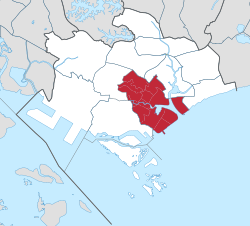City of Singapore (historical entity)
 From Wikipedia - Reading time: 5 min
From Wikipedia - Reading time: 5 min
Singapore | |
|---|---|
City | |
| City of Singapore | |
Port view, 1960 Victoria Theatre and Memorial Hall High Street, 1963 Raffles Hotel Supreme Court and City Hall buildings Bumboats on the Singapore River | |
 The Central Area (in red) of Singapore today, mostly corresponds with the former city from 1965. | |
| Coordinates: 1°17′30″N 103°51′00″E / 1.29167°N 103.85000°E | |
| Country | (1826–1963) (1963–1965) |
| State | (1951–1959) (1959–1965) |
| Government | |
| • Type | City council |
| • Mayor | Ong Eng Guan |
| Area | |
• Total | 17.84 km2 (6.89 sq mi) |
| Demonym | Singaporean |
| Time zone | UTC+07:30 (MALT) |
| Postal districts | 1, 6, 7, 8, 9 |
The City of Singapore existed between 1951 and 1965 in the Colony of Singapore, a British Crown colony and later in the State of Singapore within Malaysia, with the City Council as the governing authority. Before 1951, the City Council was known as the Municipal Commission.[1] The rest of the crown colony was under the authority of the Singapore Rural Board. The city served as the capital of Colony of Singapore, and the State of Singapore from 1951 until its abolishment in 1965.[1][2]
Today, the Central Area, which sits in the south-eastern corner of Singapore, mostly corresponds with what was once the City of Singapore.
History
[edit]Creation and subsequent elections
[edit]In the 1948 and 1951 general elections in Singapore, constituencies were drawn along the boundary of the Municipal Commission and the Rural Board, each area was subdivided into a number of constituencies.[3][4]
The municipality was then conferred with city status by a royal charter from King George VI on 22 September 1951, when Singapore was then a Crown colony.[1] The original Municipal Commission was therefore renamed as the City Council, and the Municipal Building was renamed City Hall.
Between the 1957 election and the phasing out of the city, Ong Eng Guan of the People's Action Party (PAP) was the mayor as the leader of the largest party within the City Council. Ong went on to become Minister of National Development under Lee Kuan Yew's premiership.
Dissolution
[edit]After the PAP gained power following the 1959 general election and formed the first government after self-government was granted to the Crown colony, the city was phased out, with powers transferred to statutory boards.[5]
In 1965, upon Singapore's expulsion from Malaysia, the Republic of Singapore Independence Act 1965 provided the following clause which empowered the President to abolish the City Council and the Rural Board, with the powers of the local authorities assumed by the Government.
President may by order make such modifications in any written law as appear to him to be necessary or expedient in consequence of the abolition of the City Council and of the Rural Board and of the assumption of the powers of the local authorities by the Government.
See also
[edit]References
[edit]- ^ a b c "City day". Singapore Infopedia. National Library Board.
- ^ "The story of the two city halls". The Straits Times (Archived on NewspaperSG). 20 September 1953. Retrieved 3 March 2024.
- ^ "Singapore Legislative Council General Election 1948". Archived from the original on 24 January 2023. Retrieved 27 March 2015.
- ^ "Singapore Legislative Council General Election 1951". Archived from the original on 27 July 2020. Retrieved 27 March 2015.
- ^ "Singapore Elections". Archived from the original on 28 January 2022. Retrieved 27 March 2015.
 KSF
KSF




